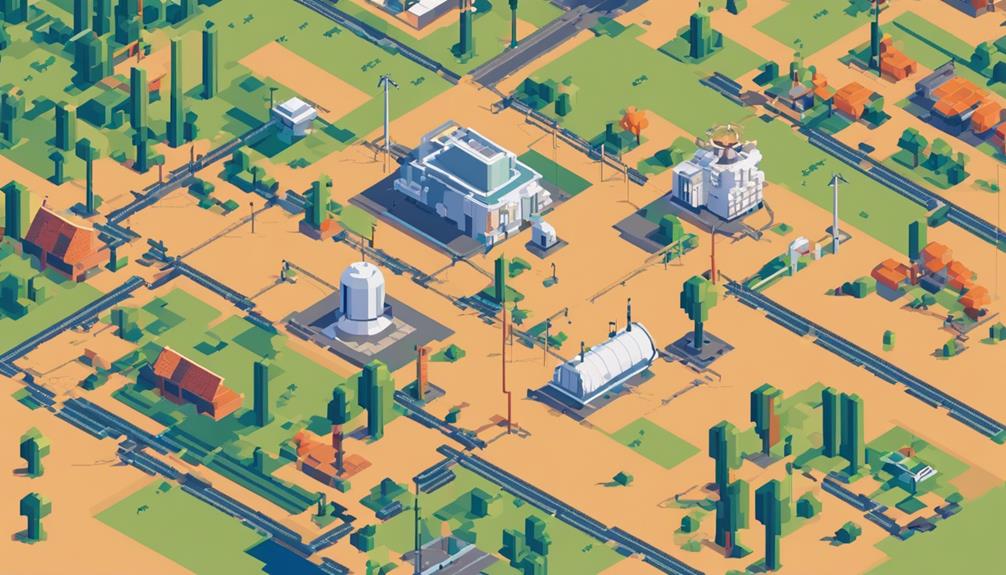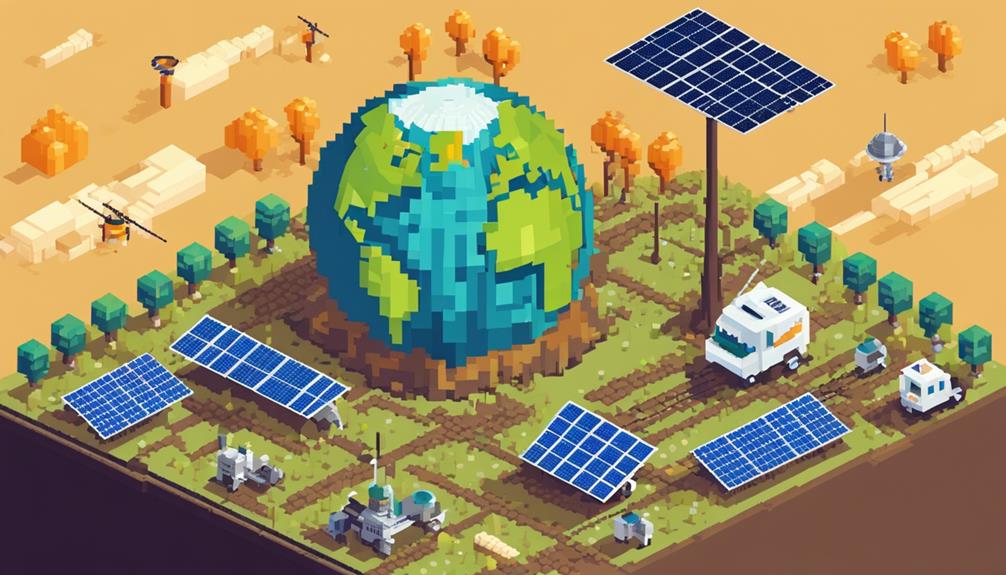The environmental impact of satellites is a multifaceted issue that warrants careful examination. From the production processes to end-of-life disposal, each stage presents unique challenges that can have far-reaching consequences. Resource consumption, light pollution, and the management of space debris are just a few aspects that demand attention. As we navigate the complexities of satellite technology's environmental footprint, exploring mitigation strategies and policy considerations becomes imperative. The delicate balance between technological advancement and environmental stewardship in the realm of satellite operations is a conversation worth exploring further.
Key Takeaways
- Satellite production and operations heavily rely on scarce resources, demanding sustainable practices.
- Satellite constellations disrupt nighttime sky visibility, impacting stargazing experiences and research.
- Light pollution from satellites affects aesthetics and wildlife, raising concerns for the night sky.
- Maintenance, disposal, and trade-offs in satellite operations require advanced technologies for environmental mitigation.
Satellite Production Processes

Satellite production processes encompass intricate procedures involving the utilization of scarce or rare elements, which significantly contribute to environmental impacts. The manufacturing of satellites involves the use of materials like aluminum or titanium alloys, with aluminum being the preferred choice due to its desirable properties. However, the extraction and processing of these raw materials come with environmental consequences such as deforestation, habitat destruction, and increased greenhouse gas emissions.
Moreover, the production of lithium batteries for satellites poses additional challenges. The manufacturing of these batteries is energy-intensive and often involves the extraction of lithium through environmentally damaging processes. This not only contributes to carbon emissions but also raises concerns about the social impacts on communities near lithium extraction sites.
Furthermore, the launch vehicles used to transport satellites into space require substantial amounts of raw materials, exceeding the material consumption of the satellites themselves. Booster stages of these launch vehicles are typically discarded into the ocean after use, resulting in the wastage of valuable materials and posing risks to marine ecosystems. Consequently, the satellite manufacturing process plays a crucial role in the overall environmental impact of satellite technology and highlights the need for sustainable practices in the aerospace industry.
Resource Consumption During Operations
The operational phase of satellite technology involves the management and utilization of resources across various components, including launch vehicles and ground installations. Although satellites, launch vehicles, and ground installations are not highly resource-demanding relative to overall raw material use, the manufacturing processes for satellites do rely on scarce or rare elements that have environmental impacts. Satellites are predominantly made of aluminum or titanium alloys, with aluminum being the preferred choice due to its lightweight properties. However, the manufacturing of these alloys and the collection of raw materials, such as lithium for batteries, can have negative environmental and social implications.
In comparison to satellites, launch vehicles require larger quantities of raw materials, further contributing to resource consumption during operations. The production of launch vehicles involves processes that consume significant amounts of raw materials, adding to the overall environmental impact of satellite operations. Therefore, while satellites themselves may not be as resource-intensive during their operational phase, the combined resource use of satellites, launch vehicles, and ground installations warrants careful consideration of their environmental impacts. Efforts to optimize resource consumption and reduce the environmental footprint of satellite operations are crucial in mitigating the overall impact on the environment.
Impact on Nighttime Sky Visibility

Satellite constellations, particularly those like Starlink, have raised concerns among astronomers due to their disruptive impact on nighttime sky visibility. The proliferation of satellites has resulted in light pollution effects, hindering stargazing experiences and impeding astronomical research activities. These factors collectively contribute to the degradation of the natural aesthetic of the night sky and pose significant challenges for ground-based observatories and ongoing celestial observations.
Light Pollution Effects
Artificial luminance emanating from orbiting technological apparatus poses a significant challenge to the natural observation of celestial phenomena during nocturnal hours. Satellite light pollution, particularly from satellite constellations like Starlink, disrupts stargazing and astronomical observations by creating bright streaks in the night sky, hindering the visibility of celestial objects. This interference not only impacts the aesthetics of the nighttime sky but also hampers scientific research. Moreover, the increasing number of satellites raises concerns about the long-term effects on the quality of the night sky, affecting astronomers and the general public alike. The alteration of natural light cycles due to satellite light pollution can also have adverse effects on wildlife behavior, ecosystems, and human well-being.
Astronomical Research Disruption
How does the increasing presence of satellite technology impact the visibility of the nighttime sky for astronomical research purposes? The proliferation of satellites in low Earth orbit, exemplified by projects like Elon Musk's Starlink, has introduced a significant challenge to astronomical research. These satellites traverse the night sky, leaving bright streaks that interfere with observations and imaging. Astronomers are increasingly concerned about the detrimental effects on delicate astronomical instruments and radio astronomy caused by these artificial lights in the sky. The interference of satellites with ground-based observatories and low-Earth orbit facilities crucial for astronomical research poses a threat to the quality and reliability of data collected. Therefore, the environmental impact of satellite constellations on the night sky is a growing concern for the astronomical community.
Impaired Stargazing Experiences
The proliferation of satellite mega constellations has significantly impacted stargazing experiences by saturating the night sky with bright swarms of satellites. This interference with nighttime sky visibility has raised concerns among astronomers and the general public regarding the effects on astronomical observations and radio astronomy activities. The presence of numerous satellites has led to satellite photobombing of astronomical observations, hindering ground-based and low-Earth orbit facilities' ability to conduct research effectively. Additionally, the radio communications from satellites pose challenges for sensitive radio astronomy instruments, affecting the quality of observations and potentially impeding groundbreaking discoveries in the field of astronomy.
Ground-Based Infrastructure Challenges

The challenges associated with ground-based infrastructure for satellite technology encompass limitations in infrastructure capacity, complexities in resource allocation, and the intricacies of maintenance requirements. Addressing these issues is crucial to ensure the uninterrupted operation and sustainability of satellite communication systems. Efforts to optimize energy consumption, enhance operational efficiency, and mitigate environmental impacts are paramount in overcoming these challenges.
Infrastructure Limitations
Addressing the limitations of ground-based infrastructure is crucial in ensuring the efficient operation and performance of satellite systems.
- Limited tracking stations and communication networks pose challenges for satellite data transmission.
- Geographic limitations of ground stations impact coverage and data acquisition.
- The construction, maintenance, and continual upgrades of ground-based infrastructure require significant investments of both time and money.
Ensuring the reliability of satellite ground stations through constant monitoring and maintenance is essential to maintain seamless data transmission. With evolving satellite technology and increasing data demands, the need for robust ground-based infrastructure remains a critical aspect of satellite operations.
Resource Allocation Issues
Efficient resource allocation is a critical aspect of addressing ground-based infrastructure challenges in satellite operations. Managing resources such as energy, water, and land for ground stations is essential due to the significant demands imposed by satellite communication networks. Data centers and processing facilities play a crucial role in supporting satellite data transmission and analysis, further increasing resource requirements. Balancing resource allocation is key to ensuring sustainable satellite operations amidst growing concerns about climate change and environmental monitoring. By optimizing resource allocation, such as minimizing energy consumption and land usage, the impact of satellite operations on the environment can be mitigated. Strategic resource allocation is vital for addressing ground-based infrastructure challenges and promoting environmentally conscious satellite practices.
Maintenance Complexities
Ground-based infrastructure maintenance for satellites involves intricate systems dedicated to tracking, communication, and control, essential for supporting satellite operations.
- Specialized Equipment: Maintenance facilities require specialized equipment and trained personnel to ensure the smooth functioning of satellites in orbit.
- Global Ground Stations: Ground stations around the world play a crucial role in monitoring and communicating with satellites, aiding in their maintenance and operation.
- Challenges and Solutions: Challenges such as climate variations, space junk interference, and communication disruptions can impact maintenance activities. Implementing robust maintenance protocols and advanced technologies can help mitigate these challenges and ensure the effective operation of satellites, including those like the International Space Station (ISS).
Decommissioning and End-of-Life Disposal

Ensuring the proper decommissioning and end-of-life disposal of satellites is crucial in mitigating space debris and maintaining the sustainability of space operations. With over 3,000 defunct satellites currently orbiting the Earth, responsible disposal practices are essential to prevent collisions and the creation of additional space debris. End-of-life disposal methods typically involve controlled re-entry into the Earth's atmosphere, where satellites are designed to burn up upon re-entry, minimizing the environmental impact. Alternatively, satellites can be boosted into higher orbits to reduce the risk of collision with operational spacecraft.
To adhere to debris mitigation guidelines, satellites should ideally be de-orbited within 25 years of the end of their mission. This timeframe aims to limit the accumulation of space debris and reduce the potential for collisions in space. By following these guidelines and employing responsible end-of-life disposal practices, the long-term sustainability of satellite technology and space operations can be ensured. It is imperative for satellite operators and space agencies to prioritize the safe disposal of decommissioned satellites to safeguard the orbital environment for future missions and space activities.
Environmental Trade-Offs in Satellite Technology
Satellite technology introduces a complex array of environmental trade-offs, encompassing resource utilization, atmospheric impacts from launches, and disturbances to the nocturnal sky.
- Resource Use: Satellites require a significant amount of resources during manufacturing, deployment, and operation. The extraction of raw materials, energy consumption in production, and the disposal of defunct satellites all contribute to environmental degradation and resource depletion.
- Atmospheric Consequences: Rocket launches, a crucial aspect of satellite deployment, release pollutants and greenhouse gases into the atmosphere. These emissions can have adverse effects on air quality, contribute to climate change, and impact the health of ecosystems and human populations.
- Light Pollution: The increasing number of satellites in orbit has raised concerns about light pollution. The reflection of sunlight by satellite surfaces can interfere with astronomical observations, disrupt wildlife behavior patterns, and affect the circadian rhythms of various species.
Furthermore, the risk of satellite collisions in crowded orbital pathways poses a threat to operational satellites and the generation of space debris. Addressing these environmental trade-offs requires careful consideration of sustainable practices, responsible resource management, and the development of technologies to minimize the negative impacts of satellite technology on the environment.
Mitigation Strategies for Environmental Impact

Mitigation strategies for mitigating the environmental impact of satellite technology encompass a range of innovative solutions and regulatory frameworks aimed at promoting sustainable space activities. Deorbiting satellites at the end of their operational lifetimes is a key strategy to reduce space debris and minimize atmospheric impacts. This practice involves safely removing satellites from orbit, either by moving them to a graveyard orbit or causing them to re-enter the Earth's atmosphere where they burn up.
Additionally, active debris removal technologies are being developed to address the risks associated with satellite collisions and the accumulation of space debris. These technologies aim to capture defunct satellites and other debris, removing them from critical orbits to reduce the likelihood of collisions that can generate further debris fields.
International guidelines and regulations play a crucial role in promoting responsible space activities and mitigating the environmental impacts of satellite technology. By outlining best practices for satellite operators and establishing frameworks for cooperation in space, these regulations help minimize the risks posed by satellite collisions and space debris, ultimately contributing to a more sustainable space environment.
Policy and Regulation Considerations
In light of escalating concerns regarding the environmental impact of satellite mega constellations, regulatory bodies are currently evaluating policy and regulation considerations to address these challenges effectively. The following are key points to consider in this regard:
- Regulatory actions: There is a growing need for regulatory bodies to take action in response to the environmental concerns raised by satellite mega constellations. This includes potentially imposing restrictions on satellite operators to mitigate their impact on the environment.
- Environmental reviews: The US Government Accountability Office (GAO) has recommended revisiting environmental reviews for satellite projects. This suggests a move towards more comprehensive assessments of the environmental implications of such ventures.
- Global precedent: Any restrictions imposed on satellite operators in the US could set a global precedent for environmental protection in the satellite industry. This could influence regulatory decisions and practices worldwide, leading to more environmentally conscious approaches to satellite deployment.
These considerations highlight the importance of proactive policy and regulation measures to ensure the sustainable development of satellite technology while minimizing its environmental impact. Regulatory bodies play a crucial role in balancing the advancement of satellite mega constellations with environmental preservation, setting the stage for a more sustainable future in space exploration and telecommunications.
Future Sustainability Efforts in Satellite Technology

Efforts in advancing sustainability within satellite technology are increasingly focused on reducing environmental impacts across satellite lifecycle stages. With the growing number of satellites being launched into space, there is a pressing need to address the potential environmental consequences. One key area of focus is reducing emissions associated with satellite manufacturing, launch, operation, and disposal. By optimizing resource use, enhancing propulsion systems, and improving end-of-life disposal methods, the satellite industry aims to minimize its carbon footprint and overall environmental impact.
Innovations in satellite design and manufacturing play a crucial role in achieving sustainability goals. Efforts are being made to increase the efficiency of satellites, reduce waste generation during production, and implement environmentally friendly materials. Furthermore, optimizing launch processes, such as using more fuel-efficient rockets and reducing the number of debris-producing collisions, can significantly contribute to reducing the environmental footprint of satellite missions.
Collaboration between industry stakeholders, governments, and regulatory bodies is essential for driving sustainable practices in satellite technology. Establishing guidelines and standards for sustainable satellite design, operation, and disposal is paramount to ensuring the long-term viability of space activities while mitigating potential environmental risks. Sustainable satellite technology is not only a technological necessity but also a moral imperative in safeguarding our planet's environment for future generations.
Frequently Asked Questions
What Are the Environmental Impacts of Satellites?
Satellites contribute to environmental impacts through space debris, light pollution, wildlife disruption, and resource depletion. Space debris from satellite collisions poses risks to operational satellites and increases space junk. Light pollution affects ecosystems, wildlife behavior, and stargazing. Satellite operations deplete resources like fuel and materials. Effective mitigation strategies, such as de-orbiting satellites at the end of their lifetimes, are essential for managing these environmental impacts and ensuring sustainable satellite operations.
What Is the Role of Satellite in Environment?
Satellites play a pivotal role in environmental monitoring by providing crucial data on climate change, ecosystem health, pollution tracking, and conservation efforts. Through satellite monitoring, valuable insights into climate change impacts are gathered, aiding in the preservation of ecosystems. Satellite data contributes significantly to enhancing conservation efforts and understanding environmental dynamics. The technology's observations help track environmental changes, supporting the sustainability of our planet.
What Is the Impact of Satellites?
Satellites have significant environmental impacts, including satellite pollution, space debris generation, high energy consumption, and light pollution. Satellite pollution results from rocket launches, emitting pollutants and greenhouse gases. Space debris poses risks to operational satellites and spacecraft. High energy consumption is required for satellite operation and communication. Light pollution from satellites disrupts ecosystems and astronomical observations. Implementing mitigation strategies is crucial to address these environmental impacts effectively.
How Do Satellites Affect the Atmosphere?
Satellites impact the atmosphere through emissions, contributing to air pollution and potential ozone depletion. Advanced satellite technology aids climate change studies with data collection. Monitoring atmospheric composition, satellites play a crucial role in environmental analysis. Careful consideration is essential to mitigate these effects and ensure sustainable space operations. The intricate interplay between satellite emissions and atmospheric dynamics underscores the importance of environmental consciousness in space exploration.
